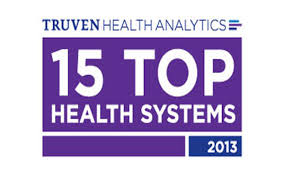Top Hospitals Achieve Superior Clinical Outcomes, Fewer Patient Safety Events
Truven Health Analytics, formerly the Healthcare business division of Thomson Reuters, has released its 5th annual study identifying our nation’s leading health systems. The Truven Health 15 Top Health Systems study looked at culled data from more than 300 organizations, identifying the top 15 hospital systems achieving superior clinical outcomes.
Key findings from the Truven study include:
- Top 15 Health Systems experienced 3.4 percent fewer deaths than non-winning peer-group hospitals.
- Winning systems’ 30-day mortality rates were lower than peer systems’, and small winning systems outperformed their peers by the widest margin.
- Patients of the winning health systems had 3 percent fewer complications than patients in other systems.
- Patients treated in the winning system hospitals had a median average length of stay of 4.49 days, over half a day shorter than their peers’ median of 5.06 days.
- Top health systems had 7 percent fewer adverse patient safety events than expected, given the case mix of the particular hospital, and had better adherence to core measures of care than their peers.
The study divides the top health systems into three comparison groups based on operating expenses of member hospitals. The winners are as follows:
Large Health Systems (more than $1.5 billion total operating expense)
- Advocate Health Care, Oak Brook, IL
- Banner Health, Phoenix, AZ
- Memorial Hermann Health System, Houston, TX
- OhioHealth, Columbus, OH
- Scripps Health, San Diego, CA
Medium Health Systems ($750 million–$1.5 billion)
- Alegent Creighton Health, Omaha, NE
- Exempla Healthcare, Denver, CO
- Mission Health, Asheville, NC
- Prime Healthcare Services, Ontario, CA
- TriHealth, Cincinnati, OH
Small Health Systems (less than $750 million)
- Asante, Medford, OR
- Cape Cod Healthcare, Hyannis, MA
- Mercy Health Southwest Ohio Region, Cincinnati, OH
- Poudre Valley Health System, Fort Collins, CO
- Roper St. Francis Healthcare, Charleston, SC
The following is the methodology used to conduct the study:
U.S. health systems with two or more short-term, general, non-federal hospitals; cardiac, orthopedic, and women’s hospitals; and critical access hospitals were assessed in the study. Researchers looked at eight metrics that gauge clinical quality and efficiency: mortality, medical complications, patient safety, average length of stay, 30-day mortality rate, 30-day readmission rate, adherence to clinical standards of care (evidence-based core measures published by the Centers for Medicare & Medicaid Services), and HCAHPS patient survey score (part of a national initiative sponsored by the United States Department of Health and Human Services to measure the quality of care in hospitals). The study relied on public data from the 2010 and 2011 Medicare Provider Analysis and Review (MedPAR) data and the CMS Hospital Compare data sets.
You can read and download the full study here.

